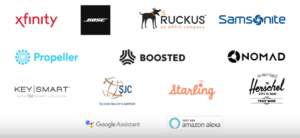Tile: Dude, where are my keys?

Tile is creating the Internet of Things for those things that we often lose, namely our wallets and our keys. The company has created Bluetooth trackers which pair with a mobile application. While the original trackers were intended for keys, the company released the Tile Slim in 2016 intended to slide into a wallet, and the Tile Sport in 2017 with an enhanced water-proof design intended for outdoor objects. The battery life of a Tile lasts for a year, at which point one has to use the company’s replacement program, essentially creating a yearly subscription. By January 2018, the company had sold 13 million Tiles.[1]
Scaling its Platform:
Tile sells new users the Bluetooth trackers for $35, however existing users can “reTile” for $25 by sending in their old tracker to the company, enticing existing users to continue to use the subscription. This low price point, yet sticky model allowed the company to bring in $100 million revenue in 2016.
However, the company has broader plans than a subscription model, as it has focused primarily on partnerships to scale it platform (see partners below). 
Tile states that it can help its partners to “create goodwill and differentiation with enhanced functionality that delivers real benefits to your customers.”[2] Tile is partnering with both Bluetooth enabled and non-Bluetooth enabled products. In January 2018, the company announced a partnership with Bose that will allow users of Bose wireless headphones to locate their headphones using Tile’s technology embedded within the headphones. Samsonite is also planning to integrate Tile’s technology into their luggage this year. Lastly, Tile is aintegrating with Amazon Alexa and Google Assistant so users can use either the Echo or Google Home to help locate their items.
Network Effects:
Tile is attacking the main pain point with its product (the Bluetooth trackers only have a range of ~200 feet) by creating a Tile community and leveraging the inherit network effects. The Tile Community Find feature “allows you to anonymously enlist the help of our entire community in your search. It works both ways—if you’re running the app in the background and come within range of someone’s lost item, we’ll let the owner know where it is.”[3] There are obvious Network Effects here as the Community Find feature becomes more effective and useful when more and more people are on the Tile app. However, the very short tracker range will limit Tile’s ability to create far-reaching global network effects as the company will only be able to leverage network affects within densely populated urban areas.
New Entrants:
While Tile has undoubtedly had a lot of success in its first five years, there is not a lot preventing competitors to enter the “Lost & Found” technology market. TrackR, founded 3 years before Tile in 2009, has 5 million devices in market compared to Tile’s 13 million.[4] Chipolo, founded in 2013, has sold over a million devices. In order to differentiate in this market, Tile must continue to focus on scaling its platform through partnerships. The more partnerships Tile will be able to create, the more users the company will have, and the more powerful the network effects will be.
[1] https://techcrunch.com/2018/01/08/lost-item-finder-tile-will-work-with-bose-headphones-and-other-new-partners/
[2] https://www.thetileapp.com/en-us/smart-location-platform
[3] https://www.thetileapp.com/community-find?utm_source=pepperjam&utm_medium=affiliate&utm_term=21181
[4] https://www.fastcompany.com/3069233/bluetooth-trackers-and-the-race-to-help-you-find-your-stuff



Thanks for the post! Had never thought of Tile as a platform company – very interesting to hear about them partnering with Bose and others to use their location tech. Will be curious to see if the community of users is actually able to achieve impactful direct network effects – perhaps if enough people have them they may be able to do so in the vein of Wayze. Meanwhile, I will have to go trade in my old Tile for the slim!
I really enjoyed reading this blog post. This has been an ongoing issue of mine and I never realized there was a company with the technology to help address this issue. I wonder if they have invested enough in advertising the product to extract more value and agree with your statement that in an easy to enter the market like this one with very little technological hurdles the key path to success will be through partnerships.